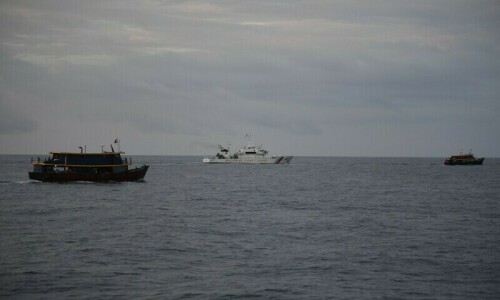
ISLAMABAD: The headline inflation measured by the Consumer Price Index (CPI) surged to a nearly 49-year high of 27.3pc in August from a year earlier, official data showed on Thursday, mainly driven by rising food and energy prices.
Price hikes in staples, including vegetables, wheat and cooking oil, led the high inflation, the Pakistan Bureau of Statistics (PBS) said in a statement. In July, annual CPI inflation was 24.9pc, the highest in over 14 years.
By contrast, August’s 27.3pc inflation was the highest on record since 1973-1974, PBS spokesman Ateequr Rehman told Dawn.com. Meanwhile, Arif Habib Corporation said the figure was the highest since November 1973.
The CPI index has since mostly remained below 15pc, with a few exceptions in November 2008, when it was recorded at 24.3pc.
August’s CPI index at 27.3pc said to be highest on record since November 1973
Inflation has been on the rise after fuel prices skyrocketed since the last week of May, as the new coalition government scrapped costly fuel subsidies to tame the surging fiscal deficit and revive a stalled IMF loan programme.
According to the PBS, August inflation in urban and rural areas increased to 26.24pc and 28.7pc year-on-year, respectively. On a month-on-month basis, the CPI showed an increase of 2.45pc.
The inflationary trend was driven by a double-digit increase in almost all sub-indices, especially transport, food and housing, and utilities.
On a year-on-year basis, the transport index saw the biggest rise of 63pc in August, followed by perishable food items 33.85pc, non-perishable food items 28.85pc, housing and utilities 27.57pc, restaurants and hotels 27.43pc, alcoholic beverages and tobacco 25.78pc, and furnishing and household equipment maintenance 21.86pc.
Other categories included recreation and culture 21.78pc, miscellaneous goods and services 19.97pc, clothing and footwear 17.63pc, health 11.89pc, education 9.99pc, and communication 1.23pc.
Apart from CPI, other inflationary indicators like the Sensitive Price Indicator (SPI) and Wholesale Price Index (WPI) also saw substantial spikes in August. SPI rose to 34pc in August from 28.2pc a month earlier and 15.9pc in the same month last year. WPI stood at 41.2pc compared to 38.5pc in the previous month and 17.1pc a year ago.
Last week, the Monthly Economic Update and Outlook for August reported that heavy monsoon rains have adversely affected major and minor crops, which may impact the country’s agricultural performance and its overall economic outlook.
Official data showed that food inflation remained on the higher side in August, as it shot up to 28.8pc year-on-year and 1.6pc month-on-month in urban areas, whereas the respective growth in prices in rural areas was 30.2pc and 1.2pc — a reversal of the trend where urban areas usually experience higher food prices.
Food items whose prices rose in August compared to the previous month included tomatoes (52.85pc), pulse moong (15.27pc), vegetables (13.44pc), pulse mash (12.47pc), pulse masoor (11.76pc), eggs (7.53pc), besan (6.5pc), pulse gram (6.08pc), gram whole (5.67pc), potatoes (4.99pc), beans (3.07pc) and cooking oil (2.34pc).
In urban areas, however, the prices of fruits dropped by 19.98pc, chicken by 11.54pc and vegetable ghee by 0.74pc. A similar trend was noticed in the prices of essential food items in rural areas.
Non-food inflation in urban centres increased to 24.7pc year-on-year and 3.3pc month-on-month, whereas in rural areas, it rose to 27.5pc and 3.1pc, respectively. The increase in non-food inflation was mainly driven by unprecedented rising oil prices.
In the non-food category, the items whose prices saw an increase in August from the previous month included electricity charges (19.73pc), liquefied hydrocarbons (8.53pc), readymade garments (7.85pc), construction input items (7.53pc), stationery (7.29pc), cleaning and laundering (6.73pc), motor vehicle accessories (5.20pc), cotton cloth (4.67pc) and furniture and furnishing (2.33pc).
The core inflation in urban areas was 13.8pc in August against 12pc the previous month. In rural areas, the increase was 16.5pc against 14.6pc. This shows that the increase in interest rates also could not stop the upward trend in core inflation.
Published in Dawn, September 2nd, 2022














































Dear visitor, the comments section is undergoing an overhaul and will return soon.